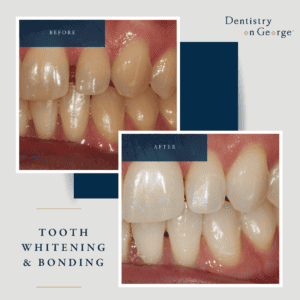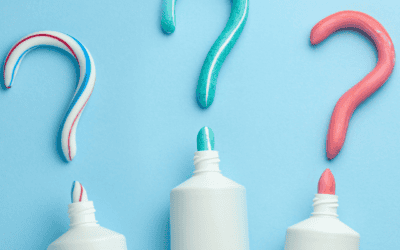Tooth whitening is surging in popularity and some sources even say it’s the most commonly requested dental procedure (1). Tooth whitening is the process where stained or discoloured teeth are lightened using a chemical agent. Done properly, it is safe, effective and easy to do. However, tooth whitening done incorrectly can cause damage to teeth and gums. Read on for our top tips to get the most out of your tooth whitening.
Understanding how tooth whitening works
Understanding the process of tooth whitening and how it works can help our patients to use it correctly and get the best results. Tooth whitening can be done in a number of ways, using different methods and chemicals. At Dentistry on George, we like to provide a home-whitening kit, with custom-fitted trays that go over your teeth, and specialist whitening gels. We recommend this treatment, as it has been shown to be more effective and safer than over-the-counter products. One study carried out in the UK compared whitening with a control of 10% carbamide peroxide (one of the products that we use at Dentistry on George) with 5 over the counter products. They found that the over the counter products had variable whitening results and that they caused damage to the tooth enamel (2).
The active ingredient in whitening products is hydrogen peroxide. We can use whitening gels that are hydrogen peroxide, or that are carbamide peroxide, as carbamide peroxide breaks down into hydrogen peroxide and water. The hydrogen peroxide further breaks down into water, oxygen and free radicals. The free radicals oxidise the stains within the tooth to lighten the colour of the tooth. They gels can only do this if they are held tightly against the tooth for the recommended working time. To do this we create custom-fitted whitening trays to hold the tooth whitening gel close to the teeth for maximum effectiveness. This also keeps the gel off the gums. The gel can burn the gums if not contained properly within the trays. In addition, poorly fitting trays or ‘off the shelf’ ones means that more gel will escape out which means it won’t be as effective and can be swallowed.
This oxidising process to remove stains takes time. On average, tooth whitening is used daily for around 4-6 weeks to get the desired results, but everyone is different. Some kinds of discolouration can take a few months to lighten. Other people due to sensitivity perhaps can’t whiten every day and so it will take longer. Therefore, patience is key!

Proper Preparation
Everybody’s teeth will whiten differently – we are all unique. Some teeth will whiten easily, others won’t whiten as well. Some people may have false teeth, veneers, crowns or visible white fillings. These will not whiten. It’s therefore important to have a thorough dental assessment prior to teeth whitening to ascertain the likely results and limitations for you. Any underlying pathology should be treated first – this could include dormant infections within teeth, untreated tooth decay or poorly sealed fillings. This is because the whitening gels can penetrate these areas and lead to pain. Teeth covered in plaque and calculus (the hard deposit that builds up on your teeth) will not whiten effectively. To get the most out of your tooth whitening treatment, it is recommended to have a professional clean first, to make sure all stains and build up are removed.
Prior to commencing tooth whitening, the dentist will also take your medical history into account. Some people can develop allergies to tooth whitening. In addition, you shouldn’t use tooth whitening products while pregnant or breastfeeding. The dentist will talk through your treatment options, weighing up the risks and benefits. If tooth whitening is suitable for you, they can recommend which type is best.

Understanding The Risks
At home tooth whitening done correctly and under supervision by a dental professional is very safe. However, as with all treatments, there are risks and side effects which should be taken into consideration before starting. Risks can be mitigated by selecting the correct product and method of tooth whitening.
Other whitening products and services
There are many whitening products available online. However, these are not well regulated. When you undergo tooth whitening by a dental professional, they are bound by strict guidelines and only certain approved products can be used. Unregulated products can either not work, or they can cause chemical burns and damage the teeth. Some products sold in stores may not have high enough strength of the active ingredient, or may contain ingredients not proven to whiten teeth.
The majority of whitening toothpastes actually just contain abrasives. These are designed to scratch off surface stains. They may remove some staining, but they won’t actually lighten the colour of your teeth. In addition, some can be too abrasive and actually damage the tooth surface. Colgate’s Optic White contains a small percentage of hydrogen peroxide. This may not lighten very dark teeth, but it can be effective to remove some surface stains and to maintain a white smile for those that have already undergone tooth whitening procedures.
There are some companies that will whiten your teeth in salons or at home. They advertise ‘dental grade’ tooth whitening. While the products may be stronger, the staff are not dental professionals and so can’t assess for other problems that may cause issues with tooth whitening e.g., tooth decay, high risk of tooth sensitivity, risk of allergy or why the teeth are discoloured in the first place. This means products may not work or could damage teeth.

Why Dental Professionals are the best people to carry out whitening
Before we recommend any kind of tooth whitening, we will take some things into consideration:
- Your age (certain types of tooth whitening are not recommended for children)
- Your medical history, especially any allergies
- Pregnancy/breastfeeding – tooth whitening is not recommended
- The reason for tooth discolouration – the nature of the discolouration will also be taken into account. Heavily discoloured teeth may require further treatment by a different means to get the desired aesthetic appearance.
- Any previous dental work
- Any future planned dental work
- Any untreated gum disease or tooth decay
We will also ensure we give you clear instructions on how to use the product, to limit any side effects and ensure you are using it safely.
Being aware of the side effects so you can counteract them
The most common side-effect of tooth whitening is tooth sensitivity. However, your dentist has many tricks and tools to help keep this to a minimum. If your teeth are sensitive prior to starting tooth whitening, your dentist will assess why. This may require some fillings on to root surfaces exposed by gum recession, or it may involve the use of topical ‘desensitisers’ in the few weeks before starting your tooth whitening.
Another tip is to have some breaks from the tooth whitening. We know from the literature, that the teeth tend to get the most sensitive on the 3rd day of tooth whitening. You can skip a day or two every 2nd or 3rd day if required. Or we can provide more at home desensitisers.
Make sure you are using the products as directed. Putting in extra gel, or wearing for longer, thinking it will happen quicker won’t work. Too much product will leak over on to gums and cause damage. Leaving it in longer won’t actually mean it works quicker. Using a product designed for 30 minutes per day for longer, for example overnight, can actually cause devastating irreversible damage to the teeth.

Being realistic about results
As mentioned previously, not all teeth will lighten. Your dentist will assess the cause of the discolouration. Some types of discolouration will take longer, for example, those caused by some antibiotics, or from developmental problems with the enamel. To get the desired cosmetic results, the teeth may require further treatment in the form of bonded fillings, crowns or veneers.
Unfortunately your lovely bright and lightened teeth will not last forever. The lighter shade will regress over time. However, the beauty of the take-home kit is that you can buy top up whitening gels to give your teeth a boost when needed.
However, it’s important to not take this too far. Some people love their white teeth so much and get hooked on whitening. Teeth can end up looking worse as they lose their lustre. This is why it’s important to keep seeing your dentist and check-in for reviews so they can monitor how you are going.

A great result using a combination of tooth whitening and bonding some filling material. Results will vary from person to person, and other treatment options may be better suited.
Knowing how to maintain your whiter smile
In addition to helping you safely carry out your tooth whitening, your dental professional will give you advice on how to care for your teeth and maintain your beautiful smile. You can also see our previous blog Tips for a Brighter Smile for further information.
Make sure you brush and floss before you put your tooth whitening trays in. Removing plaque and food particles from around and in-between your teeth will mean the gels can penetrate more effectively for the best results. It will also help prevent against tooth decay and gum disease.
Avoiding heavily coloured foods and drinks will help you get the desired results and help prevent regression. To maintain a whiter smile we should try and avoid staining drinks like tea, coffee and red wine, and staining foods like berries and those containing a lot of turmeric.

So you want to whiten your teeth, what’s next?
Your teeth whitening journey at Dentistry On George begins with a consultation and dental examination. We take pride in offering honest and realistic advice so that you know what kind of results you can expect.
At the consultation appointment we will:
- Check the health of your teeth and gums
- Assess the reason for your discolouration and likely best course of action to help you achieve the results you want, bearing in mind the limitations and side effects of the treatment
- Address any dental treatment required prior to whitening
- Map out a step-by-step plan customised to your needs
- Take into consideration all aspects of your dental health, including your dental history, tooth sensitivity and the condition of your gums.
- Go through the costs involved and the risks vs benefits of treatment to help you make an informed decision.
References:
- https://www.sciencedirect.com/science/article/abs/pii/S1532338214000499
- https://www.nature.com/articles/s41415-019-0011-6



